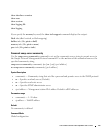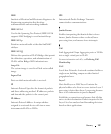
174 Glossary
Baud
The number of signaling elements transmitted each
second.
Best Effort
Traffic is assigned to the lowest priority queue, and
packet delivery is not guaranteed.
Boot Version
The boot version.
BootP
Bootstrap Protocol.
Enables a workstation to
discover its IP address, an IP address of a BootP
server on a network, or a configuration file loaded
into the boot of a device.
BPDU
Bridge Protocol Data Unit
. Provide bridging
information in a message format. BPDUs are sent
across device information with in Spanning Tree
configuration. BPDU packets contain information
on ports, addresses, priorities, and forwarding costs.
Bridge
A device that connect two networks. Bridges are
hardware specific, however they are protocol
independent. Bridges operate at Layer 1 and Layer 2
levels.
Broadcast Domain
Devices sets that receive broadcast frames
originating from any device within a designated set.
Routers bind Broadcast domains, because routers do
not forward broadcast frames.
Broadcasting
A method of transmitting packets to all ports on a
network.
Broadcast Storm
An excessive amount of broadcast messages
simultaneously transmitted across a network by a
single port. Forwarded message responses are
heaped onto the network, overloading network
resources or causing the network to time out.
For more information about broadcast storms, see
"Configuring Load Balancing".
C
CDB
Configuration Data Base.
A file containing a
device’s configuration information.
Class of Service
Class of Service (CoS).
Class of Service is the
802.1p priority scheme. CoS provides a method for
tagging packets with priority information. A CoS
value between 0-7 is added to the Layer II header of
packets, where zero is the lowest priority and seven
is the highest.
A overlapping transmission of two or more packets
that collide. The data transmitted cannot be used,
and the session is restarted.
Combo Ports
A single logical port with two physical connections,
including an RJ-45 connection and an SFP
connection.


















